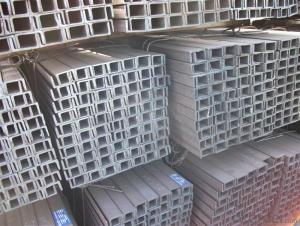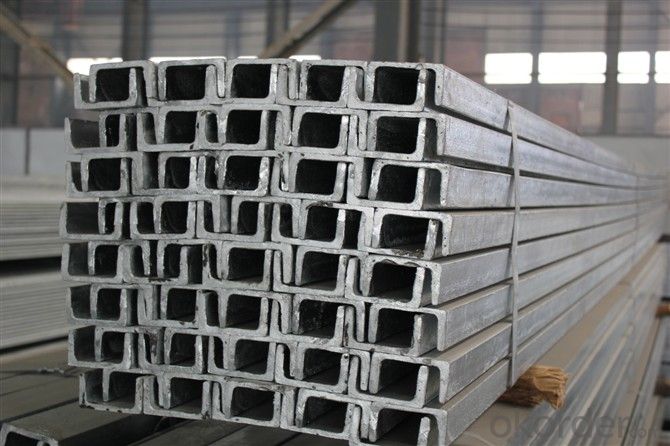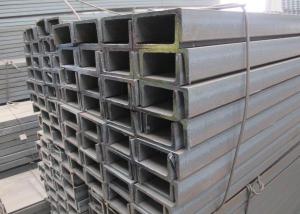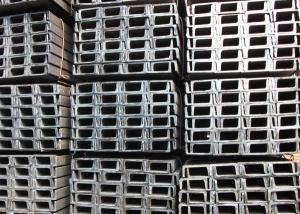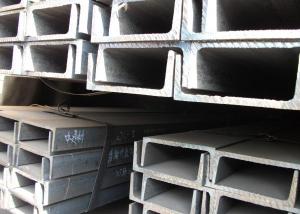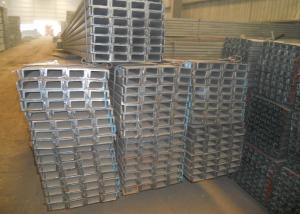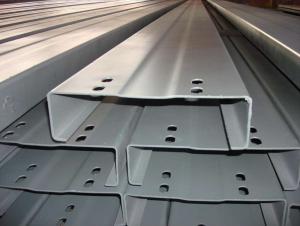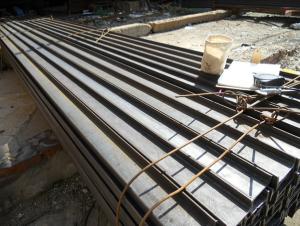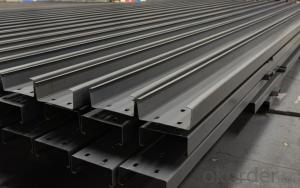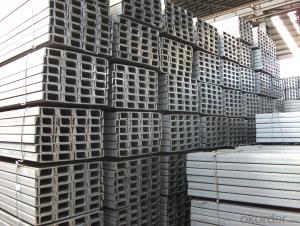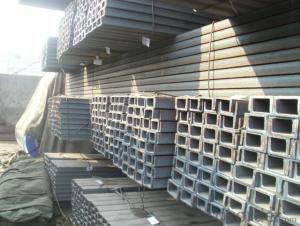Hot Rolled Steel channel U-Channel Channel steel for sale Made In China
- Loading Port:
- Tianjin
- Payment Terms:
- TT or LC
- Min Order Qty:
- 50 m.t.
- Supply Capability:
- 10000 m.t./month
OKorder Service Pledge
OKorder Financial Service
You Might Also Like
Product Description:
OKorder is offering Hot Rolled Steel channel U-Channel Channel steel for sale Made In China at great prices with worldwide shipping. Our supplier is a world-class manufacturer of steel, with our products utilized the world over. OKorder annually supplies products to European, North American and Asian markets. We provide quotations within 24 hours of receiving an inquiry and guarantee competitive prices.
Product Applications:
Hot Rolled Steel channel U-Channel Channel steel for sale Made In China are ideal for structural applications and are widely used in the construction of buildings and bridges, and the manufacturing, petrochemical, and transportation industries.
Product Advantages:
OKorder's Hot Rolled Steel channel U-Channel Channel steel for sale Made In China are durable, strong, and resist corrosion.
Main Product Features:
· Premium quality
· Prompt delivery & seaworthy packing (30 days after receiving deposit)
· Corrosion resistance
· Can be recycled and reused
· Mill test certification
· Professional Service
· Competitive pricing
Product Specifications:
Standard | GB/JIS |
Material Grade | Q235,SS400 |
Technique: | Hot Rolled |
Sizes as per chinese standard: | 50*37*4.5mm - 300*89*11.5mm |
Sizes as per japanese standard: | 50*25*3mm – 200*80*7.5mm |
Length: | 6meter, 9meter, 12meter |
Packaging & Delivery of Hot Rolled Steel U-Channel
1. Packing: it is nude packed in bundles by steel wire rod
2. Bundle weight: not more than 3.5MT for bulk vessel; less than 3 MT for container load
3. Marks:
Color marking: There will be color marking on both end of the bundle for the cargo delivered by bulk vessel. That makes it easily to disting Applications of MS Channel:
The MS Channel can be applied to construction of warehouses, workshops, sport stadiums and car parks etc.The hot rolled channel steel belongs to carbon structural steel which is applied to in the field of construction and machinery.In details, the hot rolled channel steel is usually used for arch-itechtural structure, and they could be welded in order to support or hang a vari-ety of facilities. They are also usually used in combination with I beam. Generally,the hot rolled channel steel we supply must possess perfect welding property, riveting property and mechanical property and so on.
Package & Delivery of MS Channel:
1.The hot rolled channel steel will be packed in bundle with steel wire at each end of every bundle and color marking in order to help the customer to recognize his goods more easily at sight.
2. And the hot rolled channel steel could be loaded into 20ft or 40ft container, or by bulk cargo.If the weight of each bundle reaches more than 3.5 mt, the loading by break bulk cargo should be choosed.When the weight of each bundle reaches less than 3mt, the loading by container should be choosed.
3.As for the transportaion from mill to loading port, the truck will be usually used. And the maximum quantity for each truck is 40mt.
4.All in all, we could do in accordance with customer's request
FAQ:
Q1: Why buy Materials & Equipment from OKorder.com?
A1: All products offered byOKorder.com are carefully selected from China's most reliable manufacturing enterprises. Through its ISO certifications, OKorder.com adheres to the highest standards and a commitment to supply chain safety and customer satisfaction.
Q2: How do we guarantee the quality of our products?
A2: We have established an advanced quality management system which conducts strict quality tests at every step, from raw materials to the final product. At the same time, we provide extensive follow-up service assurances as required.
Q3: How soon can we receive the product after purchase?
A3: Within three days of placing an order, we will begin production. The specific shipping date is dependent upon international and government factors, but is typically 7 to 10 workdays.
Q4: What makes stainless steel stainless?
A4: Stainless steel must contain at least 10.5 % chromium. It is this element that reacts with the oxygen in the air to form a complex chrome-oxide surface layer that is invisible but strong enough to prevent further oxygen from "staining" (rusting) the surface. Higher levels of chromium and the addition of other alloying elements such as nickel and molybdenum enhance this surface layer and improve the corrosion resistance of the stainless material.
Q5: Can stainless steel rust?
A5: Stainless does not "rust" as you think of regular steel rusting with a red oxide on the surface that flakes off. If you see red rust it is probably due to some iron particles that have contaminated the surface of the stainless steel and it is these iron particles that are rusting. Look at the source of the rusting and see if you can remove it from the surface.
Images:
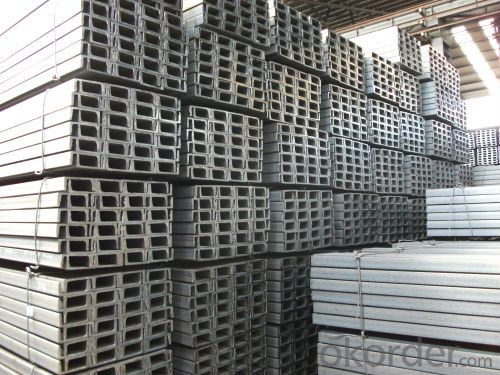

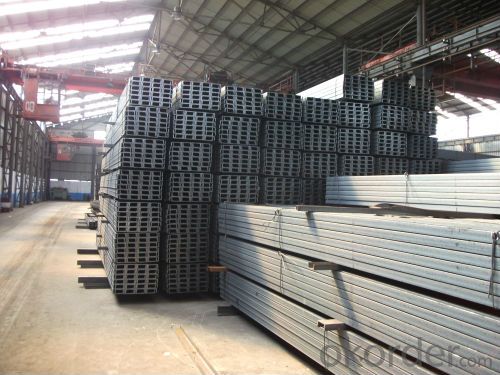
- Q: Channel
- Channel steel is a long strip steel with a cross section, and belongs to the construction and mechanical carbon structural steel. It is a complex section steel, whose cross section has a groove shape. Channel steel is mainly used in building structure, curtain wall engineering, mechanical equipment and vehicle manufacturing, etc..
- Q: What about channel 16?
- The specifications are expressed in millimeters of height (H) * leg width (b) * waist thickness (d), such as 100*48*5.3, which means waist height is 100 mm, leg width is 48 mm, waist thickness is 5.3 mm channel, or 10# channel steel. The same height of the channel, if there are several different leg width and waist thickness, also need to add a, B, C on the right side of the model to distinguish, such as 25#a, 25#b, 25#c and so on.
- Q: What are the different installation techniques for steel channels?
- There are several different installation techniques for steel channels, depending on the specific requirements and intended use of the channels. Here are a few common methods: 1. Welding: One common technique is to weld the steel channels to the supporting structure. This involves using a welding machine to melt the metal and create a strong bond between the channel and the structure. 2. Bolting: Another technique is to use bolts to secure the steel channels to the supporting structure. This method is often used when the channels need to be easily removable or adjustable. 3. Adhesive bonding: In some cases, adhesive bonding can be used to install steel channels. This involves using a strong adhesive to bond the channels to the supporting structure. Adhesive bonding can be a good option when welding or bolting is not feasible. 4. Mechanical fasteners: Steel channels can also be installed using mechanical fasteners such as screws, nails, or rivets. This method is typically used for lighter-duty applications or when a temporary installation is required. 5. Sliding or sliding-fit installation: For certain applications, steel channels can be installed by sliding them into pre-formed slots or grooves in the supporting structure. This method allows for easy installation and removal of the channels as needed. It is important to consider the specific requirements of the project, including load-bearing capacity, durability, and ease of installation, when choosing the most appropriate installation technique for steel channels. Consulting with a structural engineer or construction professional is recommended to ensure the proper installation method is chosen for the specific application.
- Q: Can steel channels be used for fencing?
- Yes, steel channels can be used for fencing. Steel channels are versatile and strong, making them suitable for various fencing applications. They can be used as posts, rails, or supports in a fencing system. Steel channels provide durability and stability, making them an excellent choice for both residential and commercial fencing projects. Additionally, steel channels can be easily customized to meet specific fencing requirements, such as height, design, and security needs. Overall, steel channels offer a reliable and long-lasting solution for fencing purposes.
- Q: Can steel channels be used for structural support?
- Yes, steel channels can be used for structural support. Steel channels have excellent strength and load-bearing capabilities, making them suitable for various structural applications such as supporting beams, columns, and frameworks in buildings, bridges, and other infrastructure projects.
- Q: Are steel channels suitable for underground applications?
- Yes, steel channels are suitable for underground applications. They are durable, strong, and resistant to corrosion, making them ideal for withstanding the harsh conditions found underground. Additionally, steel channels can be easily customized to fit specific requirements, making them versatile for various underground applications.
- Q: Can steel channels be used in the construction of soundproof walls?
- Soundproof walls can be constructed using steel channels. Steel channels, also known as steel studs or metal studs, are widely used in the construction industry due to their strength, durability, and versatility. When building soundproof walls, it is crucial to minimize any gaps or weak spots that could allow sound to pass through. By using steel channels, a solid framework can be created for the wall, ensuring a tight and secure structure that effectively blocks sound transmission. In the construction of soundproof walls, steel channels are typically employed as the framing material. They are installed vertically from floor to ceiling and horizontally between the top and bottom plates to establish a robust framework. This framework is then filled with soundproofing materials like insulation, mass-loaded vinyl, or acoustic panels to enhance the wall's soundproofing capabilities. The rigidity and strength of steel channels make them suitable for supporting heavy soundproofing materials, ensuring the wall remains intact even under significant sound pressure. Furthermore, steel channels are resistant to warping, rotting, and termite infestations, making them a durable option for long-lasting soundproof walls. However, it is important to acknowledge that the overall effectiveness of a soundproof wall depends on various factors, such as the selection of soundproofing materials, construction techniques, and proper installation. Steel channels alone may not provide complete soundproofing, as sound can still travel through other elements like doors, windows, or the ceiling. Therefore, it is essential to adopt a comprehensive approach to soundproofing, addressing all potential weak points in the construction process to achieve optimal results.
- Q: How do steel channels contribute to the overall stability of a bridge?
- Steel channels, which are often used in the construction of bridges, play a crucial role in ensuring the overall stability and structural integrity of the bridge. These channels, also known as structural steel sections, provide several key contributions to the bridge's stability. First and foremost, steel channels help distribute the load and weight of the bridge evenly across its span. By acting as horizontal beams, they effectively transfer the loads from the bridge deck to the supporting piers or abutments. This load distribution helps prevent any localized stress concentration, ensuring that the bridge can withstand the forces it encounters, such as the weight of vehicles, wind, or seismic events. Furthermore, steel channels also contribute to the torsional stability of the bridge. Torsional forces can occur due to various factors, including uneven loading, wind gusts, or the bridge's own weight distribution. By incorporating steel channels strategically in the bridge's design, these sections resist torsional forces, preventing any twisting or warping of the structure. This ensures that the bridge remains stable and maintains its intended shape over time. Additionally, steel channels enhance the overall stiffness and rigidity of the bridge. By connecting various structural elements, such as beams and columns, they provide an effective bracing system. This bracing prevents excessive deflection or bending of the bridge under loads, reducing any potential for deformation or failure. The added stiffness and rigidity provided by steel channels also help minimize the bridge's vibrations, ensuring a smoother and more comfortable experience for users. Moreover, steel channels offer versatility in their design and installation. They can be fabricated into various shapes and sizes, allowing engineers to tailor the bridge's structural components to the specific requirements of the project. This adaptability facilitates the optimization of the bridge's stability, enabling it to withstand different loads and environmental conditions. In conclusion, steel channels play a significant role in contributing to the overall stability of a bridge. They provide load distribution, torsional stability, stiffness, and rigidity, ensuring that the bridge can safely support the intended traffic loads and withstand external forces. Their versatility also allows engineers to create efficient and optimized bridge designs, enhancing the overall structural integrity and longevity of these essential infrastructural elements.
- Q: How do steel channels perform in corrosive environments?
- Steel channels are generally known for their durability and strength, but their performance in corrosive environments can vary depending on the specific type of steel used and the severity of the corrosive conditions. In general, steel channels are resistant to corrosion due to their protective oxide layer that forms on the surface when exposed to oxygen in the air. This layer acts as a barrier, preventing further oxidation and protecting the steel from corrosion. However, when exposed to corrosive environments such as saltwater, acidic solutions, or industrial chemicals, the protective oxide layer can be compromised, leading to potential corrosion. The performance of steel channels in corrosive environments can be enhanced by using corrosion-resistant alloys or coatings. Stainless steel channels, for example, contain chromium and other alloying elements that provide excellent corrosion resistance. These channels are highly resistant to rust and can withstand even the most challenging environments. In more severe corrosive conditions, additional protective measures such as galvanizing or epoxy coatings can be applied to steel channels. Galvanizing involves coating the steel with a layer of zinc, which acts as a sacrificial anode, protecting the underlying steel from corrosion. Epoxy coatings create a barrier between the steel and the corrosive environment, preventing direct contact and minimizing the risk of corrosion. It is important to note that even with these protective measures, steel channels may experience corrosion over time, especially if not properly maintained. Regular inspection, cleaning, and maintenance can help identify and address any signs of corrosion early on, prolonging the lifespan and performance of the steel channels in corrosive environments. Overall, while steel channels can perform well in corrosive environments, it is essential to consider the specific conditions and choose the appropriate type of steel, coatings, or alloys to ensure optimal performance and longevity.
- Q: Can steel channels be used in modular construction?
- Indeed, steel channels find application in modular construction. Given their robustness, resilience, and adaptability, steel channels enjoy popularity as fundamental elements within modular construction. Their exceptional capacity for providing support and stability to modular structures enables them to endure varying loads and environmental circumstances. Moreover, the ease of fabrication and assembly of steel channels renders them suitable for the expeditious and efficient construction process demanded by modular construction. In summary, steel channels emerge as a dependable and effective option for modular construction endeavors.
Send your message to us
Hot Rolled Steel channel U-Channel Channel steel for sale Made In China
- Loading Port:
- Tianjin
- Payment Terms:
- TT or LC
- Min Order Qty:
- 50 m.t.
- Supply Capability:
- 10000 m.t./month
OKorder Service Pledge
OKorder Financial Service
Similar products
Hot products
Hot Searches
Related keywords
